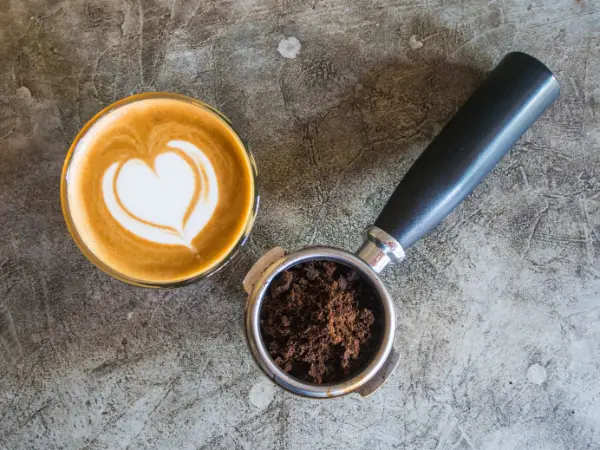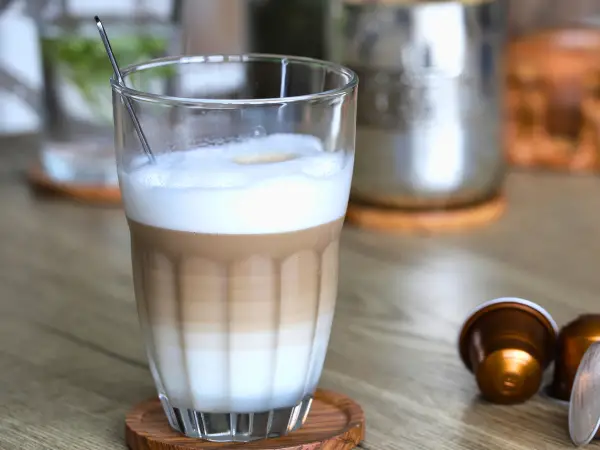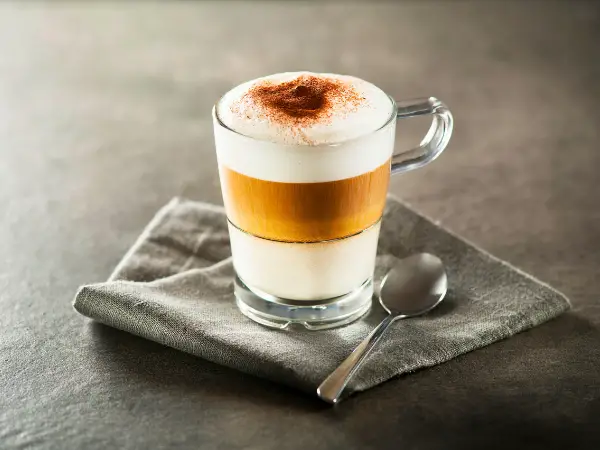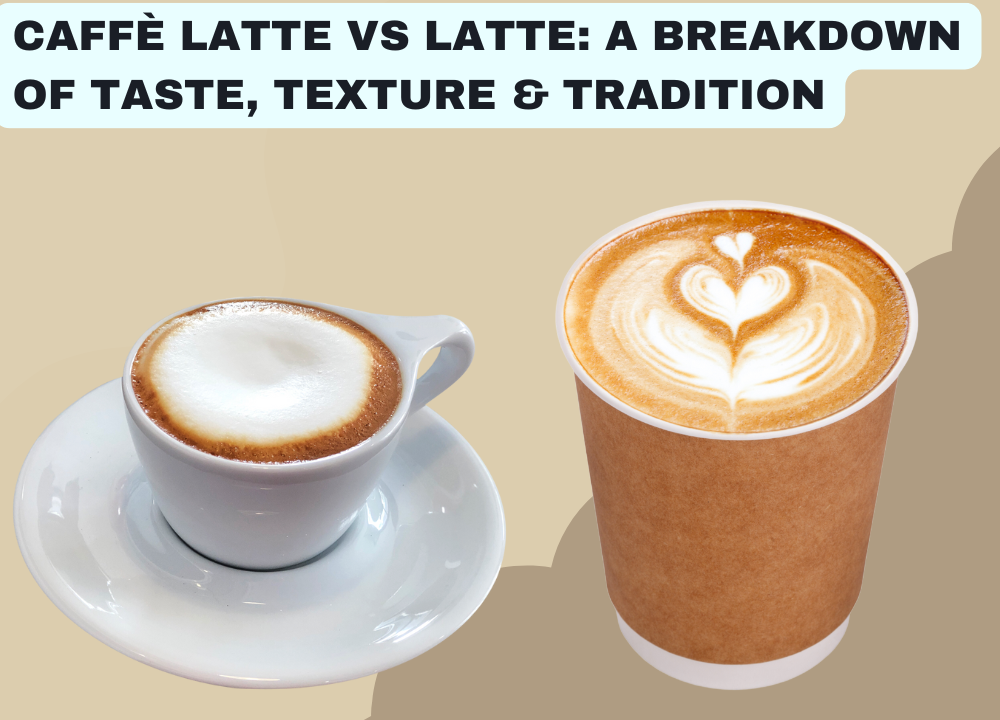Caffè latte and latte may sound similar, but they offer different experiences. Both drinks are popular choices in coffee shops, yet their taste, texture, and traditions vary.
Each drink has its own unique flavor and feel, shaped by ingredients and preparation methods. Caffè latte typically has a stronger espresso flavor, while latte often emphasizes milk.
Understanding The Basics Caffè Latte And Latte
Understanding the basics of these two beverages helps coffee lovers appreciate their unique qualities. Both drinks share similar ingredients but differ in preparation and presentation.
What Is A Caffè Latte?
A Caffè Latte is an Italian coffee drink made with espresso and steamed milk. It is typically served in a larger cup, making it a popular choice in Italy. The drink features a smooth blend of flavors with a minimal milk foam on top. Here are some key points about Caffè Latte:
- Espresso with steamed milk: The base is always a shot of espresso.
- Minimal milk foam on top: Just a thin layer of foam is used.
- Popular in Italy: Traditionally served in larger cups.
- Simple flavor: The focus is on the espresso and milk blend.
For those who enjoy a balanced drink, Caffè Latte offers a creamy texture and rich taste. It is ideal for coffee drinkers who prefer a milder coffee experience.
What Is A Latte?
A Latte, especially in North America, often features more milk and a thicker layer of foam than a Caffè Latte. This drink can be flavored with syrups, giving it a sweet twist. Here are some aspects of a Latte:
- Espresso with more milk: Contains more steamed milk than a Caffè Latte.
- Thick layer of foam: The foam is usually richer and creamier.
- Common in North America: This version is widely popular in cafes.
- Often flavored: Many enjoy adding syrups for extra taste.
The Latte offers a creamier and sweeter coffee experience. Those who like rich flavors and textures often opt for this drink. Its versatility allows for various flavor combinations.
Are They The Same Drink?
Caffè Latte and Latte may seem similar, but they have small differences in texture and flavor. Here is a comparison:
| Feature | Caffè Latte | Latte |
|---|---|---|
| Milk Amount | Less milk | More milk |
| Foam | Minimal foam | Thick foam |
| Origin | Italy | North America |
| Flavor | Balanced | Sweetened options available |
In summary, Caffè Latte is an Italian term with a focus on espresso and steamed milk. Latte in the U.S. often has more milk foam and allows for flavor additions. These differences make each drink unique.

Key Differences In Ingredients And Preparation Caffè Latte And Latte
Understanding these key differences can enhance your coffee experience. Let’s explore how the espresso-to-milk ratio, milk texture, and serving styles differentiate Caffè Latte from Latte.
Espresso-To-milk Ratio Comparison
The espresso-to-milk ratio is a crucial aspect of Caffè Latte and Latte. Both drinks use espresso, but the amount of milk varies.
Here’s a quick comparison:
| Drink | Espresso | Milk |
|---|---|---|
| Caffè Latte | 1/3 espresso | 2/3 steamed milk – light foam |
| Latte | 1/3 espresso | More steamed milk – thicker foam |
The Caffè Latte has a creamier texture due to the higher milk content. This makes it smooth and easy to drink. The thicker foam on a Latte adds a richer mouthfeel.
Steamed Vs. Frothed Milk: What’s The Difference?
The type of milk used makes a significant difference in taste and texture. Understanding steamed milk and frothed milk helps clarify this difference.
- Steamed Milk:
- Smooth
- Creamy
- Less airy
- Frothed Milk:
- More foam
- Airy
- Used in lattes
Caffè Latte primarily features steamed milk. This creates a velvety texture that complements the espresso. On the other hand, Lattes use frothed milk. This adds a delightful foam layer on top.
How Each Drink Is Traditionally Served
The way Caffè Latte and Latte are served also differs. This can affect your coffee-drinking experience.
- Caffè Latte:
- Typically served in a cup or glass
- Often enjoyed plain or with a sprinkle of cocoa
- Latte:
- Served in a taller glass
- Often topped with latte art
The presentation adds to the enjoyment of both drinks. Caffè Latte feels cozy and inviting in its cup. The Latte, often adorned with artistic patterns, becomes a visual treat.

Taste And Texture Differences
Each beverage offers unique flavors and textures, resulting from different ratios of espresso, milk, and foam.
Flavor Profile Of A Caffè Latte
A Caffè Latte has a rich espresso taste. It combines one shot of espresso with steamed milk. The milk creates a creamy but balanced milkiness. The overall flavor is smooth and comforting.
- Espresso Flavor: Strong and bold.
- Milk Texture: Creamy but light.
- Foam: Less foam – smoother texture.
This drink is perfect for those who enjoy a more espresso-forward experience. The less foam allows the drinker to savor the rich espresso taste more clearly. Here’s a quick comparison of flavors in a table:
| Aspect | Caffè Latte |
|---|---|
| Espresso Intensity | More espresso, forward, less foam |
| Milkiness | Creamy but balanced |
How A Latte Tastes Compared To A Caffè Latte
A Latte differs slightly in taste. It still uses espresso and milk but has a different ratio. A Latte typically has more milk, making it a milkier and smoother drink. The espresso flavor is slightly milder. This combination gives it a different character.
- Espresso Flavor: Slightly milder espresso flavor.
- Milk Texture: Thicker milkiness.
- Foam: Frothy texture from extra foam.
Many coffee drinkers enjoy the thicker foam and creamier mouthfeel of a Latte. This drink is perfect for those who prefer a softer coffee experience. The added milk makes it less intense, allowing for a sweeter taste. Here’s a quick comparison of flavors in a table:
| Aspect | Latte |
|---|---|
| Espresso Intensity | Slightly milder – more milk |
| Milkiness | Milkier and smoother |
Which One Is Creamier?
The creaminess of a Caffè Latte and a Latte differs significantly. A Latte is generally creamier due to its thicker foam. This foam creates a rich texture that many people love. The foam sits atop the drink, making it feel luxurious.
- Caffè Latte: Less foam – smoother texture.
- Latte: More milk – thicker foam – creamier mouthfeel.
For those who enjoy a smoother drink, a Caffè Latte is ideal. The balance between espresso and milk makes it enjoyable without too much foam.

Caffeine Content And Nutritional Comparison
Understanding their caffeine content and nutritional value can help you make better choices. In this section, we will compare caffeine levels, calorie counts, and overall health benefits of these two beverages.
Caffeine Levels In A Caffè Latte Vs. A Latte
The caffeine content in both drinks mainly depends on the espresso shot. The same amount of espresso equals the same caffeine level. Typically, one shot of espresso contains 63–126 mg of caffeine per serving, depending on the size.
- Caffè Latte: Usually has one shot of espresso.
- Latte: Can also have one or two shots of espresso.
Thus, if you order a Latte with two shots, it will have a higher caffeine level than a Caffè Latte. Both drinks provide a rich coffee flavor, but the caffeine impact varies with size and espresso shots.
| Drink Type | Espresso Shots | Caffeine Content (mg) |
|---|---|---|
| Caffè Latte | 1 | 63–126 |
| Latte | 1-2 | 63–252 |
Calorie And Fat Content Breakdown
Both drinks have different calorie counts based on their milk content. The Caffè Latte uses less milk than the Latte. Here’s a quick breakdown:
- Caffè Latte: About 120 calories for an 8 oz serving.
- Latte: Approximately 150 calories for an 8 oz serving.
The additional milk in a Latte contributes to its higher calorie count. More milk also means slightly higher fat content.
Consider the following:
| Drink Type | Calories (8 oz) | Fat Content |
|---|---|---|
| Caffè Latte | 120 | Less |
| Latte | 150 | Higher |
These differences can affect your choice if you are calorie-conscious or tracking fat intake.
Which One Is The Healthier Choice?
If you prefer a drink lower in calories and milk content, the Caffè Latte is the better option. It provides a lighter choice without sacrificing the coffee flavor.
On the other hand, if you enjoy a creamier, richer texture, the Latte may be your preference. It can be heavier, especially with added flavors like syrups or whipped cream.
- Caffè Latte: Lower in calories and milk content.
- Latte: Can be more indulgent.
Your choice may also depend on dietary needs. For those managing calorie intake, the Caffè Latte stands out as the healthier choice. Consider your health goals and enjoy your coffee experience.
Popular Variations And Customizations
Caffè Latte and Latte each have unique tastes and textures. These drinks are popular among coffee lovers. Both drinks can be customized in many ways. This section explores popular variations and customizations that make each drink special.
Iced Caffè Latte Vs. Iced Latte
The iced versions of Caffè Latte and Latte offer a refreshing twist. Both drinks use chilled espresso and cold milk. However, they differ in texture and foam.
- Iced Caffè Latte:
- Smoother texture.
- Less foam.
- More balanced coffee and milk flavor.
- Iced Latte:
- More foam on top.
- Frothy and light.
- Strong coffee taste with cold milk.
Here’s a quick comparison:
| Feature | Iced Caffè Latte | Iced Latte |
|---|---|---|
| Texture | Smooth | Frothy |
| Foam | Less | More |
| Coffee Flavor | Balanced | Stronger |
Choosing between the two depends on personal taste. Some enjoy the smoothness of the Iced Caffè Latte. Others prefer the frothy experience of the Iced Latte.
Flavored Lattes: Vanilla, Caramel, And More
Flavored lattes add a fun twist to traditional drinks. Common flavors include:
- Vanilla: Sweet and creamy.
- Caramel: Rich and indulgent.
- Mocha: Chocolatey goodness.
These flavors enhance the drinks but can increase calorie count. For instance:
| Flavor | Description | Calories (Approx.) |
|---|---|---|
| Vanilla | Sweet and aromatic | 100 |
| Caramel | Rich and buttery | 120 |
| Mocha | Chocolate and coffee | 150 |
Flavored lattes can change the overall taste and texture. They offer a delightful experience for those seeking something different.
Dairy-free And Alternative Milk Options
For those who prefer non-dairy choices, many milk alternatives are available. Options include:
- Almond Milk: Light and nutty flavor.
- Oat Milk: Creamy and closest to dairy.
- Soy Milk: Thick and protein-rich.
- Coconut Milk: Sweet and tropical.
These alternatives change the flavor and texture of drinks. Oat milk is a popular choice due to its creaminess. It mimics the texture of dairy milk well.
Keep in mind:
- Dairy-free options can add sweetness.
- They may also increase the calorie count.
Choosing the right milk can enhance your coffee experience. Experimenting with different options can lead to new favorite flavors.

